Fall Protection Strategies For CMP Standing Seam Panels
Posted by Howie Scarboro - CEO Fall Protection Distributors, LLC on Nov 24th 2025
See the Roof Anchor Compatibility Chart for Construction Metal Products (CMP) Standing Seam Panels.

Who Is Construction Metal Products (CMP)?
Construction Metal Products, widely known as CMP, has built a strong reputation in the metal roofing and wall systems industry since opening its doors in 1994.
CMP's product catalog covers commercial, industrial, residential, and agricultural applications. The company produces standing-seam roof systems, panel profiles, wall panels, edge-trim packages, gutter systems, and downspouts. Its vertically integrated model gives clients access to custom lengths, project-specific details, and the quality control that only complete in-house manufacturing can provide.
Color flexibility is another advantage. CMP offers multiple color chart options for architects and builders who want to match brand visuals or blend a roof system into its surroundings. The company's work appears on a wide range of projects, including high-profile structures such as the Credit One Stadium in Charleston, SC. With facilities in Statesville, Myrtle Beach (East), and Virginia, CMP continues to expand its reach and strengthen its presence in the southeastern roofing market.
What Are the Most Compatible Fall Protection Products for CMP Standing Seam Roofs?
CMP's standing seam panels require non-penetrating fall protection anchors that match each seam type, substrate, and gauge for full OSHA compliance.
CMP manufactures several standing seam panels that use concealed clips, floating panels, and precise seam profiles to keep the roof weather-tight through seasonal temperature swings. These features make CMP's systems reliable, but they also mean not every fall protection anchor will work safely on every seam style.
This article provides safety managers, installers, and building owners with a clear view of which fall protection systems match which CMP panel profiles. Each section explains the seam type, metal gauge, and substrate options, then outlines the safest anchorage approach for that specific configuration. When the panel can support clamp loading, we recommend non-penetrating anchors such as the SSRA1 Standing Seam Roof Anchor, SSRA2 Roof Jack Adapters, SSRA3 Anchor Plates for horizontal lifeline mounting, the SSRA HLL 100 Foot Temporary Horizontal Lifeline Kit, and the Super Anchor 120 Foot Permanent Horizontal Lifeline Kit. When a seam cannot safely carry clamp force, we move to ridge-mounted anchorage such as the Ridge Pro Steep Assist ridge anchor .
By matching each panel to the correct anchorage method, crews stay protected, and the roof keeps the factory-engineered movement it needs to perform for years.
Next, we'll look at CMP's Series 3000 panels and work through each profile with the most compatible fall protection strategies.
Series 3000 T-Seam Panels
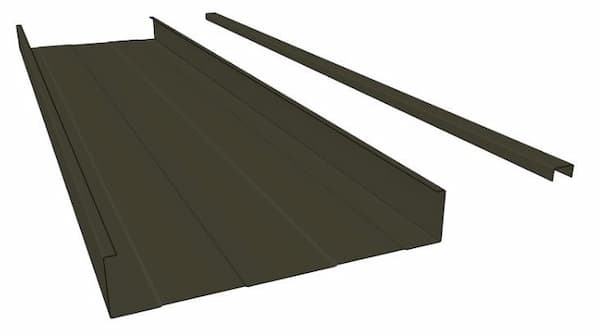
CMP's Series 3000 T-Seam panels deliver heavy-duty structural performance with a tall 3-inch seam, long spans, and reliable thermal movement.
The Series 3000 panel, often called GB3K, is CMP's structural workhorse for commercial and industrial projects that take a beating from wind and weather. The system features a 3-inch T-seam, giving the roof excellent protection against driving rain, uplift forces, and swirling winds on open sites. Contractors lean on the Series 3000 when they need a roof that holds its shape and stays weather-tight year after year. See the Roof Anchor Compatibility Chart for Construction Metal Products (CMP) Series 3000 22 Gauge and 24 Gauge Standing Seam Panels.
Thermal movement is one of the most critical factors on large roofs, and the Series 3000 handles it with ease. The hidden clips allow the panel to expand and contract as temperatures shift throughout the day without stressing fasteners or twisting the seams out of alignment. That controlled movement protects the weather seal and keeps the system performing for decades.
Serviceability sets this panel apart as well. The Series 3000 design allows crews to remove and replace individual panels when needed, a significant advantage on retrofit projects or long-term maintenance work. CMP produces Series 3000 panels in 12-inch and 15.5-inch widths, with material options including 22-gauge and 24-gauge steel, as well as .032- and .040-inch aluminum. That mix of sizes and substrates gives designers plenty of latitude to balance strength, appearance, and budget.
In short, a roof built on the Series 3000 platform brings structural capability, service flexibility, and long-term weather performance together in one of CMP's most dependable systems.
Fall Protection for Series 3000 Panels
Non-penetrating anchors on steel seams and ridge-mounted systems on aluminum keep workers safe while protecting CMP's Series 3000 T seam.
Series 3000 roofs require fall protection compatible with the T-seam design. On 22-gauge and 24-gauge steel versions, the seam is strong enough to support clamp-style anchorage, allowing crews to use the complete SSRA system. The SSRA1 Standing Seam Roof Anchor clamps onto the seam with stainless steel set screws. This assembly provides a non-penetrating tie-off point for a single worker without drilling through the metal. The SSRA1 anchor accepts various adapter plates to expand it's functionality.
When workers need a level platform on steep roofs, they can mount SSRA2 Adjustable Roof Jack Adapters onto SSRA1 anchors to create a ten-foot walkboard mount. The adapters adjust for roof pitch and seam height, helping crews keep their footing on steep metal roofs. For jobs that require horizontal mobility across wider roof areas, SSRA3 Anchor Plates mount to SSRA1 anchors and serve as connection points for temporary lifeline systems, such as the SSRA HLL 100 Foot Temporary Horizontal Lifeline Kit. That kit supports two workers and keeps the entire assembly non-penetrating from end to end.
Facilities that see regular rooftop traffic can step up to a permanent system. The Super Anchor 120 Foot Permanent Horizontal Lifeline Kit installs on 5-inch riser posts and remains in place year-round. Once that galvanized cable system is in service, maintenance crews can tie off quickly without installing temporary anchors at every visit, reducing setup time and helping protect the painted finish on steel Series 3000 panels.
Aluminum Series 3000 roofs need a different approach. Aluminum seams are non-compatible with seam anchors. A ridge-mounted option, such as the Ridge Pro Steep Assist Anchor, is the safer choice on slopes from 6:12 to 12:12. The Ridge Pro hooks over the ridge and allows workers to connect to a vertical lifeline before stepping onto the metal surface.
Series 2750 Snaplock/Mechanical Panels

CMP's Series 2750 snaplock panel offers contractors a fast-installing 2-inch profile for architectural, commercial, and light-structural roofs.
The Series 2750 panel blends clean architectural lines with the kind of performance that withstands harsh weather. CMP built this panel around a snaplock seam that installers can mechanically finish for extra protection against wind and water. The friction-fit ribs snap together with surprising speed, and most crews shave up to 25% off their installation time compared to older mechanical-lock systems. That efficiency matters on large commercial jobs when weather windows are tight. See the Roof Anchor Compatibility Chart for Construction Metal Products (CMP) Series 2750 22 Gauge and 24 Gauge Standing Seam Panels.
The panel lineup spans widths from 12 inches to 24 inches with a tall 2-inch rib height. 22-gauge or 24-gauge steel, or .032- or .040-inch aluminum are the CMP panel material options. Designers also get plenty of creative room because CMP offers the 2750 in multiple surface profiles, including flat pans, pencil ribs, planks, and striations. Those aesthetic variations let the roof blend quietly into the architecture or stand out with deeper texture.
Durability and appearance work hand in hand on this panel. The snaplock seam sheds water efficiently, the mechanical-seam option tightens the weather seal when wind exposure is high, and the wider pan choices give architects more freedom to match the look of nearby structures. That combination has made the 2750 one of CMP's most adaptable standing seam systems for retail buildings, offices, homes, and light industrial projects.
Fall Protection for Series 2750 Panels
Steel seams can support SSRA anchors, while aluminum versions require ridge-mounted systems to protect workers and the roof.
Series 2750 roofs call for fall protection solutions that respect the snaplock seam and the wide range of available substrates. For 22-gauge or 24-gauge steel, the seam is strong enough to support non-penetrating SSRA anchors. The SSRA1 Standing Seam Roof Anchor clamps to the seam using twelve stainless steel set screws at low torque, creating a certified tie-off point without drilling through the roof or crushing the seam.
Crews requiring a safe working platform can mount SSRA2 Adjustable Roof Jack Adapters on top of SSRA1 anchors. This setup holds a ten-foot walkboard and adjusts for roof pitch and seam height, giving workers a safe work surface on slopes that would otherwise slow production. When the job demands horizontal mobility, the SSRA3 Anchor Plate mounts onto the SSRA1 clamps. It serves as the connection point for temporary horizontal lifelines. Most contractors pair it with the SSRA HLL 100 Foot Temporary Horizontal Lifeline Kit, which supports two workers across large roof spans without putting holes through the panels.
Facilities that require recurring roof access often install a permanent lifeline system. The Super Anchor 120 Foot Permanent Horizontal Lifeline Kit mounts to mechanically-seamed panels and stays in service year-round, giving maintenance crews a quick, compliant way to tie off without setting temporary anchors or damaging the finish on steel Series 2750 panels.
Aluminum and copper versions of the 2750 panel demand a different strategy as they are not compatible with seam-mounted anchors. Instead, crews should rely on the Ridge Pro Steep Assist Anchor. It hooks over the peak and allows workers to clip into a vertical lifeline before stepping onto the roof. This ridge-mounted method is critical on slopes from 6:12 to 12:12, where footing becomes unpredictable.
Series 2500 Mechanical Panels
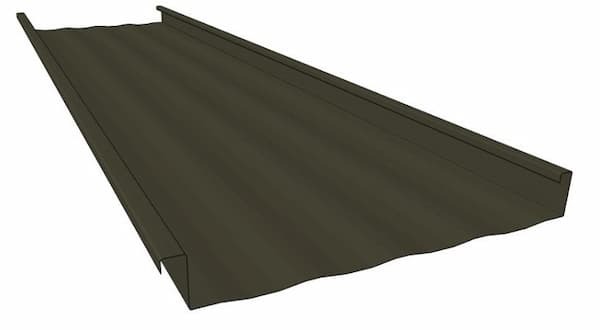
CMP's Series 2500 mechanical panels deliver a 2-inch seam, factory sealant, and optional curving for complex commercial and architectural roofs.
CMP built the Series 2500 line to handle the kind of architectural challenges that demand both strength and design flexibility. This mechanically seamed panel features a tall 2-inch rib with factory-applied sealant that keeps water out, even in high-exposure environments. Contractors can run the seams in a single-lock configuration for standard applications, or double-lock them when they need a tighter weather seal or when the roof pitch drops to as low as 1/2:12. That kind of tolerance gives designers more room to address unusual roof shapes without compromising performance. See the Roof Anchor Compatibility Chart for Construction Metal Products (CMP) Series 2500 22 Gauge and 24 Gauge Standing Seam Panels.
The Series 2500 line spans widths from 12 to 20 inches, with 16 inches being the most common size for commercial work. Crews can install the panels over solid decking or attach them directly to structural framing. CMP also offers builders a complete material range, including 22-gauge and 24-gauge steel, as well as .032- and .040-inch aluminum. That mix turns the 2500 into a good fit for everything from residential additions to large industrial buildings where durability and aesthetics matter equally.
CMP also offers a 2500-Curved version for projects needing radiused rooflines. Factory curving can tighten the radius down to 16 feet 4 inches. The curved profiles share the same seam structure, factory sealant, and material options as the flat panels, so builders don't sacrifice performance for appearance. Rooflines that once required custom fabrication now become practical with standard Series 2500 components.
Fall Protection for Series 2500 Panels
Steel seams support SSRA anchors, while aluminum panels require the Ridge Pro and ridge-mounted systems for safe, compliant tie-off.
When formed from 22-gauge or 24-gauge steel, the panels have the strength to support the SSRA line of non-penetrating anchors. The SSRA1 Standing Seam Roof Anchor grips the seam using twelve stainless-steel set screws. That low-torque attachment method gives workers a certified tie-off point without deforming the rib or voiding the roof warranty.
Crews can also mount SSRA2 Adjustable Roof Jack Adapters on top of SSRA1 anchors when a level working platform is needed. These adapters hold a ten-foot walkboard, even on steep slopes, and adjust to different rib heights. For long-span projects where crews need mobility, the SSRA3 Anchor Plate attaches to the SSRA1 clamps. It becomes the connection point for temporary lifeline systems. Most contractors pair it with the SSRA HLL 100 Foot Temporary Horizontal Lifeline Kit to give two workers full-roof mobility without drilling holes through the panels.
Buildings that require ongoing roof access benefit from installing a permanent lifeline. The Super Anchor 120 Foot Permanent Horizontal Lifeline Kit stays in place year-round and gives maintenance crews a ready tie-off method that meets OSHA and ANSI requirements. This system eliminates the need to reinstall temporary anchors each time a mechanical contractor or inspector climbs onto the roof.
Aluminum versions of the Series 2500 panel do not have the seam strength to hold seam-mounted anchors safely. For those roofs, the Ridge Pro Steep Assist Anchor becomes the best option. It hooks over the ridge and lets the worker clip into a vertical lifeline before stepping onto the metal surface. This ridge-based method is critical on slopes from 6:12 to 12:12, where footing is limited and the risk of sliding increases.
By matching the anchor system to the exact Series 2500 substrate, contractors protect their crews, preserve CMP's panel performance, and ensure compliance from start to finish.
Series 2000 Snaplock Panel

CMP's Series 2000 snaplock panels use a 1¾ inch rib and concealed clip system to deliver fast installation, strong performance, and architectural flexibility.
CMP engineered the Series 2000 to check all the boxes that builders look for in a modern snaplock panel. The system uses a 1¾ inch seam that snaps together cleanly, creating continuous shadow lines that look sharp on everything from residential accents to large commercial roof decks. Installers appreciate that the snaplock seam reduces labor by eliminating the need for field seaming on most projects. With standard widths from 12 inches to 20 inches, and 16 inches as the most common size, crews have enough options to match almost any architectural requirement. See the Roof Anchor Compatibility Chart for Construction Metal Products (CMP) Series 2500 22 Gauge and 24 Gauge Standing Seam Panels.
The Series 2000 also earns its reputation through material variety. CMP offers the panel in 22- and 24-gauge steel, as well as .032- and .040-inch aluminum. Customers can choose from more than forty PVDF-coated color finishes, plus flat, pencil-rib, planked, and striated options. CMP backs those finishes with warranties of up to 35 years, providing long-term value to building owners and contractors alike.
Performance matters just as much as aesthetics, and the Series 2000 passes the tests that count. CMP subjects the system to ASTM and UL evaluations for wind uplift, flexural strength, water penetration, and air infiltration. The panel installs on solid decking or other approved substrates with a minimum 3:12 pitch, and it uses a concealed clip system that holds the seam tightly while still allowing natural thermal expansion. For large or remote projects, CMP can bring an on-site roll former to the job so crews can produce exact lengths with minimal waste.
Fall Protection for Series 2000 Panels
Steel panels support SSRA anchors and horizontal lifelines while aluminum versions require ridge-mounted anchorage with the Ridge Pro Steep Assist.
Workers need a tie-off plan that works with the snaplock seam and the substrate beneath it. Steel Series 2000 panels provide enough seam strength to support the entire SSRA product line. The SSRA1 Standing Seam Roof Anchor grips the rib with twelve stainless-steel set screws at low torque. That connection provides workers with a certified anchorage point without drilling holes, crushing ribs, or affecting CMP's finish warranty.
When crews need a level working surface, they mount the SSRA2 Adjustable Roof Jack Adapters on top of SSRA1 anchors. That setup comes with a 10-foot walkboard, stays level on steep slopes, and adjusts to different seam heights and roof pitches. For larger roofs where mobility matters, the SSRA3 Anchor Plate mounts to the top of the SSRA1 anchors and becomes the attachment point for a temporary lifeline. Most contractors pair it with the SSRA HLL 100 Foot Temporary Horizontal Lifeline Kit for full-roof mobility while keeping seams intact.
Facilities like schools, campuses, and commercial buildings that require ongoing roof acces can benefit from a permanent system. The Super Anchor 120 Foot Permanent Horizontal Lifeline Kit stays in place year-round and provides maintenance crews with a ready tie-off point without reinstalling temporary anchors at every visit. This kit is one of the most efficient ways to maintain OSHA compliance without interrupting the roof surface.
Aluminum Series 2000 panels cannot safely hold seam-mounted clamp anchors. They require a ridge-mounted approach. The Ridge Pro Steep Assist Anchor solves that problem by hooking over the ridge and providing a secure tie-off point before the worker ever steps onto the metal surface. It performs well on pitches from 6:12 to 12:12 and remains one of the safest ways to access aluminum snaplock systems.
By matching the fall protection system to the exact Series 2000 substrate, contractors protect their crews, preserve CMP's roof performance, and maintain compliance from setup to cleanup.
Series 1500 Mechanical Panels
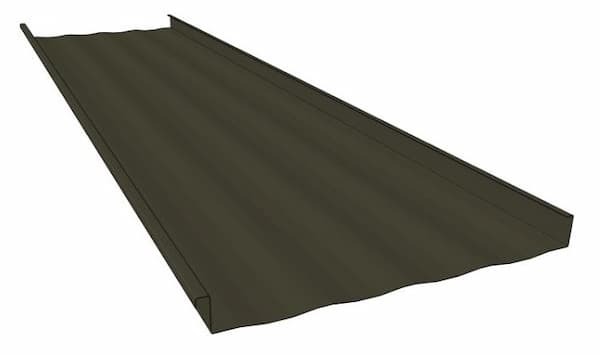
CMP's Series 1500 mechanical panels deliver adaptable single-lock and double-lock seams that support residential, light commercial, and curved architectural designs.
CMP designed the Series 1500 as a flexible mechanical-seam system that adapts to a wide range of architectural needs. The panel uses a traditional mechanically crimped seam that can be single-locked for general weather performance or double-locked for maximum watertightness. That versatility makes the Series 1500 a dependable fit for residential homes, smaller commercial buildings, and architectural projects where the roof needs to carry clean, continuous lines. See the Roof Anchor Compatibility Chart for Construction Metal Products (CMP) Series 1500 22 Gauge and 24 Gauge Standing Seam Panels.
The standard panel widths range from 12 inches to 20 inches, with 12-inch and 16-inch profiles used most often. Contractors can order custom lengths to match project-specific requirements. CMP offers the Series 1500 in 24- and 26-gauge steel, .032- and .040-inch aluminum, and 16-ounce copper. With seam heights available in 1 inch and 1.5 inches, the Series 1500 can match both traditional and contemporary design goals. The minimum slope requirement is 2:12, making the panel suitable for many residential and light commercial roof decks without compromising drainage or performance.
CMP also produces a curved counterpart, the Series 1500-Curved, for projects that join structural function with architectural expression. Barrel vaults, covered walkways, and radius roof sections often rely on this profile. CMP can factory-curve the panels to radii as tight as 10 feet, while field curving allows for sweeping arcs up to 200 feet. Both the flat and curved versions share the same material options, seam engineering, and color selections, giving designers a unified palette for complex roof geometry.
Fall Protection for Series 1500 Panels
Non-curved steel Series 1500 panels support the SSRA1 anchor and additional adapters, while aluminum, copper, and light-gauge steel require a ridge-mounted tie-off using the Ridge Pro Steep Assist.
Workers need an anchorage plan that is compatible with the mechanical seam and the substrate beneath it. Steel Series 1500 panels provide enough seam strength for the entire SSRA product line. The SSRA1 Standing Seam Roof Anchor grips the seam at low torque with twelve stainless-steel set screws and creates a certified tie-off point without puncturing the roof surface. Safety managers use this anchor on 24-gauge steel and appreciate how it preserves panel integrity while meeting OSHA and ANSI requirements.
When crews need a level working platform, they mount the SSRA2 Adjustable Roof Jack Adapters atop SSRA1 anchors. This setup includes a 10-foot walkboard that adjusts to different seam heights and provides installers with a stable surface on steep slopes. For horizontal mobility along the roof, the SSRA3 Anchor Plate mounts on top of the SSRA1. It becomes the connection point for lifeline systems. Most contractors pair it with the SSRA HLL 100 Foot Temporary Horizontal Lifeline Kit to provide continuous tie-off for two workers along long roof runs.
Facilities such as churches, schools, multi-tenant buildings, and commercial buildings that require frequent access can benefit from a year-round system. The Super Anchor 120 Foot Permanent Horizontal Lifeline Kit solves this problem by remaining permanently in place, providing maintenance crews with a ready-to-use anchorage system that never penetrates the roof surface.
Aluminum, copper, and 26-gauge steel variants of the Series 1500 cannot safely support seam-mounted anchors. These lighter materials require a ridge-based anchorage strategy. The Ridge Pro Steep Assist Anchor hooks over the ridge to provide a secure tie-off point before the worker ever steps onto the metal panel. It remains the safest method for accessing 6:12 to 12:12 roofs where the seam cannot support clamps.
Curved roof designs introduce complexities that standard fall-protection systems cannot safely address. For these reasons, a trained safety professional must inspect the Series 1500-Curved roof before selecting any fall-protection equipment.
This evaluation determines whether a ridge-based device like the Ridge Pro can serve as the primary anchorage, whether a temporary horizontal lifeline is feasible, and which access points require alternate engineered solutions. Roof shape, substrate thickness, seam style, and radius tightness all influence the anchor strategy.
By relying on expert inspection rather than assumptions, contractors protect their crews and preserve the structural integrity of CMP's curved mechanical panels. A roof-specific fall-protection plan ensures safe access, compliant tie-off points, and long-term performance for these high-visibility architectural systems.
Series 1000 Snaplock Panel
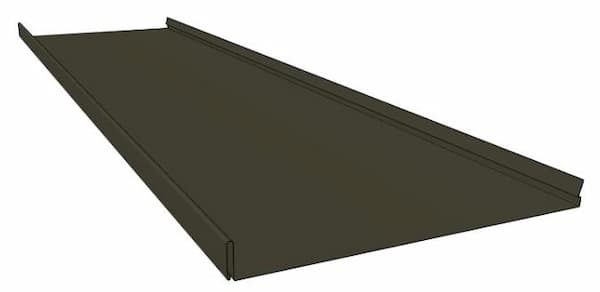
CMP's Series 1000 snaplock panels offer a clean architectural look and reliable performance, requiring substrate-specific fall protection planning.
The CMP Series 1000, often referred to as S-1000, is one of the company's most adaptable standing seam systems for residential and light commercial roofs. Its integrated snaplock seam lets installers seat panels quickly, creating smooth transitions and clean lines that fit a variety of architectural styles. Panel widths range from 12 to 20 inches, with 16 inches as the standard. The 1.5-inch seam height gives the finished roof a modern profile, and contractors can order custom lengths or roll-form the panels on-site when jobs demand it. See the Roof Anchor Compatibility Chart for Construction Metal Products (CMP) Series 1500 and 24 Gauge Standing Seam Panels.
CMP manufactures the S-1000 in 24-gauge steel, .032 and .040 aluminum, and 16-ounce copper, giving builders flexibility across budgets and project types. Finish options include flat pans, striations, pencil ribs, and plank patterns, paired with Valspar PVDF coatings that carry warranties up to thirty-five years. More than forty color choices allow designers to match nearly any exterior palette.
The snaplock design works on roof pitches as low as 3:12, provided installers follow CMP underlayment guidelines. Extensive UL and ASTM testing verifies the panel's resistance to air infiltration, wind-driven rain, and uplift.
Fall Protection For Series 1000 Panels
SSRA anchors work only on 24-gauge steel S-1000 panels; other substrates require ridge-based anchorage such as the Ridge Pro.
Safe access on the Series 1000 system depends heavily on the material used. Only the 24-gauge steel version can support non-penetrating seam-mounted anchors, such as the SSRA1. Aluminum and copper S-1000 panels cannot handle clamp compression without risking seam deformation, so those installations require ridge-mounted anchors.
For steel applications, the SSRA1 Standing Seam Roof Anchor remains the most secure non-penetrating option. It grips the snaplock seam with stainless-steel set screws. It provides a certified tie-off point without piercing the metal or interfering with the concealed clip system. When installers need a level platform for steep roof runs, they can mount SSRA2 Adjustable Roof Jack Adapters onto SSRA1 anchors and support a ten-foot walkboard.
Horizontal movement across larger roofs becomes easier with SSRA3 Anchor Plates, which mount above the SSRA1 clamps and serve as attachment points for temporary systems, such as the SSRA HLL kit featuring the Malta Dynamics HLL3001 Horizontal Lifeline Kit. This setup protects two workers and offers controlled mobility during staging, installation, or tear-off.
For S-1000 roofs made from aluminum or copper, the Ridge Pro Steep Assist Anchor is the safest solution. It hooks over the ridge and provides workers with a secure tie-off on roof pitches from 6:12 to 12:12. Because it never clamps to the seam, it avoids the risk of panel distortion and preserves the integrity of softer metals.
Selecting fall protection that matches the specific S-1000 substrate ensures worker safety, preserves CMP's roof warranty conditions, and keeps the roof performing to its engineered standard.
Tee & Curved Tee Panels (Full Batten Cap, Non-Compatible With SSRA products)
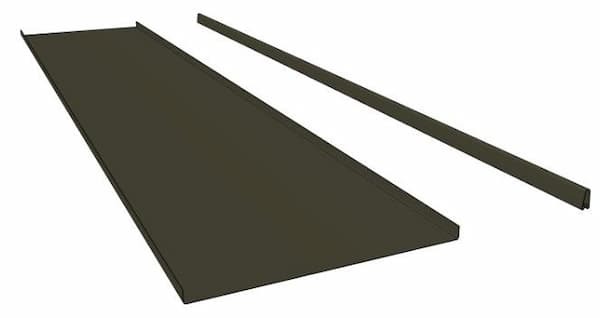
CMP's Tee and Curved Tee batten-cap panels offer complex architectural flexibility that requires ridge-based or site-specific fall protection.
CMP's Tee and Curved Tee panels offer architects and builders a standing-seam option tailored for advanced roof shapes. These batten-cap systems adapt well to steep slopes, tapered layouts, and dramatic curved features, making them a favorite for residential and commercial projects that need expressive rooflines. Standard Tee panels come in 12- and 16-inch widths and feature a 1-inch rib paired with a separate batten strip that locks each panel in place. This assembly creates a weather-resistant profile and gives buildings clean architectural lines from eave to ridge. See the Roof Anchor Compatibility Chart for Construction Metal Products (CMP) Tee & Curved Tee Full Batten Cap Standing Seam Panels.
CMP manufactures these panels in 24-gauge steel, .032- or .040-inch aluminum, and 16-ounce copper, giving designers a range of durable substrates and visual finishes. The Curved Tee variant extends the system's versatility even further by allowing factory- or field-curving down to a 4-foot radius. That capability enables the creation of domes, eyebrow accents, concave or convex curves, and other complex shapes that standard straight seams cannot achieve.
Fall Protection For Tee & Curved Tee Panels
Batten-cap Tee panels cannot support clamp-style anchors, so contractors must rely on ridge-mounted or site-specific fall protection.
Because CMP's Tee and Curved Tee systems use a full batten cap that covers the seam, they cannot support any seam-mounted anchorage. Workers need to avoid using the SSRA1, SSRA2, and SSRA3 products on these profiles. Instead, ridge-mounted fall protection is the best option.
The Ridge Pro Steep Assist Anchor remains the safest and most predictable choice. It hooks over the peak and provides a secure tie-off on slopes from 6:12 to 12:12. It works on 24-gauge steel, aluminum, and copper panel versions without risking batten damage or seam deformation. Because the Ridge Pro never clamps to the seam, it preserves panel movement and maintains CMP's weather-tight installation requirements.
Curved Tee installations behave differently. A curved batten-cap roof creates variable loads across the seam, and no universal fall-protection device can safely accommodate them. A trained fall-protection professional should evaluate the roof in person before selecting equipment. That site-specific review ensures anchors meet OSHA load requirements without compromising the curved metal's structural performance.
Choosing fall protection that matches the specific Tee or Curved Tee configuration keeps workers safe. It maintains the architectural integrity that makes these CMP systems so distinctive.
Nail Strip Panel (Non-Compatible with SSRA Products)
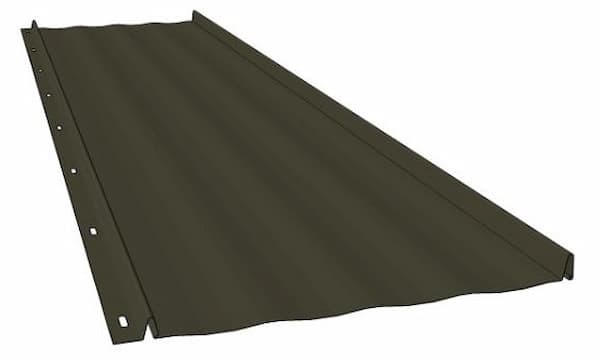
CMP's Nail Strip system uses a concealed fastener flange that requires ridge-mounted fall protection rather than seam-clamp anchorage.
The Series Nail Strip panel from CMP Construction Metal Products offers a modern roofing option built for residential and light commercial projects that use solid decking. Its concealed fastening system eliminates the need for retainer clips or exposed fasteners. Instead, each panel locks into place through a slotted securement flange that allows natural thermal movement. See the Roof Anchor Compatibility Chart for Construction Metal Products (CMP) Nail Strip Standing Seam Panels.
CMP offers the Nail Strip system in widths ranging from 12 to 20 inches, with 16 being the most common choice. The 1-inch and 1.5-inch seam heights give designers flexibility when balancing architectural style and performance requirements. The panels come in 24-gauge and 26-gauge steel, .032 aluminum, and 16-ounce copper, giving builders multiple ways to match budget, durability, and overall appearance. Finish options include flat pans, pencil ribs, planks, and striations, along with a wide range of PVDF colors backed by warranties of up to thirty-five years.
The concealed fastening system maintains a watertight surface. It provides a smooth visual line from eave to ridge, making it popular for homes, offices, and small commercial structures where aesthetics matter just as much as performance.
Fall Protection For Series Nail Strip Panels
Nail strip seams vary in shape and thickness, so contractors should use ridge-mounted tie-offs, such as the Ridge Pro Steep Assist Anchor.
The Nail Strip system installs quickly, but its seam shape introduces challenges for clamp-style anchors. Seam width, thickness, and final shape depend heavily on the machine used to form the panels. Because those variables can change from job to job, no clamp-on anchor can consistently grip a Nail Strip seam without risking deformation or loss of holding strength.
Ridge-mounted anchorage remains the safest and most consistent strategy. The Ridge Pro Steep Assist Anchor hooks over the ridge. It provides a secure tie-off before workers ever step onto the metal. It supports a 100 percent tie-off on roofs from 6:12 to 12:12 and does not rely on the seam for load-bearing. This approach protects the panel's thermal movement, prevents seam damage, and keeps the roof installation fully non-penetrating.
The Ridge Pro works across the full range of materials in the Nail Strip system, including steel, aluminum, and copper. Its simplicity and reliability make it the preferred method for crews installing or maintaining CMP's Nail Strip roofs.
Standing Seam Roof Anchor 22 Ga. Panel Compatibility For Construction Metal Products (CMP)
| Series-3000 22 Ga. | Series 2750 22 Ga. | Series-2500 22 Ga. | Series-2000 22 Ga. | Series-1500 22 Ga. | |
|---|---|---|---|---|---|
SSRA 1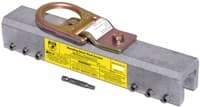 |
YES | YES | YES | YES | YES |
SSRA1 Nylon Tip |
YES | YES | YES | YES | YES |
SSRA2 Roof Jack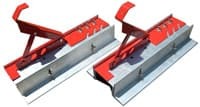 |
YES | YES | YES | YES | YES |
SSRA3 Anchor Plate |
YES | YES | YES | YES | YES |
The Ridge Pro |
YES | YES | YES | YES | YES |
Standing Seam Roof Anchor 24 Ga. Panel Compatibility For Construction Metal Products (CMP)
| Series-3000 24 Ga. | Series 2750 24 Ga. | Series-2500 24 Ga. | Series-2000 24 Ga. | Series-1500 24 Ga. | Series-1000 24 Ga. | Tee & Curved Tee | Nail Strip Panel | |
|---|---|---|---|---|---|---|---|---|
SSRA 1 |
NO | NO | NO | NO | NO | NO | NO | NO |
SSRA1 Nylon Tip |
YES | YES | YES | YES | YES | YES | NO | NO |
SSRA2 Roof Jack |
YES | YES | YES | YES | YES | YES | NO | NO |
SSRA3 Anchor Plate |
YES | YES | YES | YES | YES | YES | NO | NO |
The Ridge Pro |
YES | YES | YES | YES | YES | YES | YES | YES |
Contact Us for Expert Standing Seam Fall Protection Advice
For expert guidance on standing seam roof anchors, lifeline kits, and fall protection systems that protect both your crew and your panels, contact us today at 863-703-4522 or visit www.StandingSeamRoofAnchor.com. Our safety specialists can help you match the right non-penetrating anchor to your specific roof profile and slope. Let's make your next metal roofing project safe, compliant, and built to last. For continued learning, download OSHA's 48-page Fall Protection Manual and our free Anchor Inspection Form once you've selected the ideal anchors for your roof system. Together, we'll help you stay ahead of OSHA standards while preserving your roof's weather-tight seal.
Safety Tips For Standing Seam Roofs
Promote a Culture of Safety
A strong safety culture starts long before anyone clips into an anchor. CMP projects often involve steep pitches, long panel runs, or mixed substrates, so a quick morning conversation about hazards, weather, material handling, and tie-off strategy keeps everyone grounded. When crews talk openly about what they saw yesterday or what feels off today, the entire team becomes safer. These discussions help installers use SSRA1 anchors correctly on Series 3000, Series 2750, or other compatible CMP profiles while avoiding shortcuts that usually lead to near misses.
Use Anchor Systems Built for Standing Seam Roofs
CMP's mechanically seamed and snaplock systems rely on concealed clips that allow the panels to expand across long runs. That means fall protection must protect the roof just as much as the workers. On 24-gauge steel Series 3000, Series 2750, Series 2500, or Series 2000 panels, the SSRA1 creates a non-penetrating tie-off point without crushing the seam or restricting panel movement. It grips the metal with 12 low-torque stainless-steel set screws, eliminating the guesswork of older clamp designs and preserving CMP's weather-tight engineering.
Prioritize Ladder Safety Training
Far too many documented injuries happen on the ladder, not the roof. Reviewing the 4-to-1 setup rule, securing the ladder to the structure, and maintaining three points of contact keep everyone safer before they even reach the roof line.
Equip Workers with High-Quality Safety Gear
Workers move more confidently when their harness fits correctly, their connectors lock properly, and their Malta Dynamics Pygmy Hog or Edgehog SRL snaps into place correctly. Daily inspections of stitching, hardware, and lifeline condition create a safety baseline before anyone steps onto steel or aluminum CMP decking.
Set Up Protective Guardrail Barriers for Work Zones
Guardrails remove the need to rely on a personal fall arrest system right at the edge. They work exceptionally well around skylights, mechanical units, and low parapet areas, which are common in commercial CMP installations. Guardrail systems protect workers from dangerous conditions and areas on the roof, and reduce the risk of unexpected hazards.
Encourage the Use of Trauma Straps
Stopping the fall is just the first step in protecting the worker from injury. A suspended worker can lose circulation within minutes. Trauma straps give them a way to stand, shift weight, and keep blood flowing while the rescue team responds. Every worker using an SSRA1 seam anchor or clipping to the Ridge Pro should have trauma straps as part of their required gear.
Develop OSHA-Compliant Safety Plans
CMP offers everything from curved Series 1500-C installations to long-run Series 3000 mechanical seams, so no two jobs share the same hazards. A written plan should define tie-off locations, note where walkboards will mount to SSRA2 adapters, outline lifeline paths, and detail rescue responsibilities. Weather changes, crew size adjustments, or access modifications should trigger an update. Hence, the plan always reflects current conditions.
Ensure Proper Footwear for Stability
CMP panels can feel slick when dust settles, dew forms, or temperatures shift. Roofing boots with firm ankle support and grippy tread keep workers balanced on slippery metal roofs. Solid traction works hand in hand with SSRA1 anchors and Ridge Pro ridge tie-offs to reduce slips when workers carry panels, tools, or walkboards across long spans.
Install Permanent Roof Anchor Systems
Many CMP installations serve commercial facilities where HVAC crews, electricians, and maintenance teams return multiple times a year. Instead of repeating temporary setups, building owners can install the Super Anchor 120-Foot Permanent Horizontal Lifeline Kit. It creates a ready-to-use tie-off path that protects the roof and gives service crews a straightforward way to tie in without having to guess where anchors should go.
Consult Experts for Curved Metal Panels
CMP's curved Series 2500 and Series 1500-C profiles require more than standard equipment. Curved seams behave differently under load, and even a slight change in radius can affect clamp attachment. A trained fall protection specialist should inspect these installations before anyone selects anchors or lifeline assemblies. That evaluation ensures the plan meets OSHA requirements and protects the curved roof from damage caused by the wrong equipment.
Disclaimer
The views, recommendations, and information presented in this blog are solely those of the author and do not necessarily reflect the opinions or positions of the featured panel manufacturer, its brands, subsidiaries, or parent companies. Customers are strongly encouraged to contact the roof panel manufacturer directly for inquiries regarding fall protection compatibility with their products and to address any potential warranty issues that may arise after installing our products.

